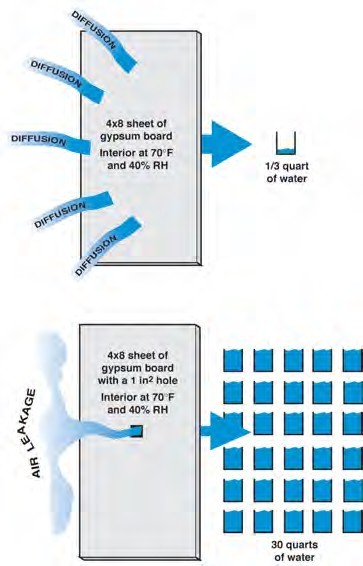Air control
Controlling the flow of air into and out of a building enclosure is essential to reducing the heating and cooling load within the enclosure. It is generally understood that air leaking out of a building takes a lot of the heating and cooling energy with it and that drafts into a building can be a significant detriment to comfort.

Over the course of a heating season in most cold climates and under normal operating conditions, air leaking through a 1 in2 hole moves much more moisture than is moved by diffusion through a 4x8 sheet of gypsum wall board.
It is also important to control airflows in order to control the entry of airborne contaminants - some of which have critical impact on health and safety - into the living space. For example, airflow control between an attached garage and living space is needed to prevent the migration of carbon monoxide (CO) - a deadly odorless gas - from the garage into the living space. In multi-unit buildings, air flow control is needed to prevent cross-contamination or the movement of airborne contaminants (e.g. tobacco smoke, cleaning products) and odors between dwelling units as well as between dwelling units and other spaces in the building. The ground on which buildings are built can be a source of radon and other undesirable soil gases. The building enclosure must resist penetration of these soil gases through the foundation and slab.
Airflow control is also important to building durability. Significant amounts of moisture can be carried by air moving into or out of the building. Dr. Joseph Lstiburek has written "Air movement as a moisture transport mechanism is typically far more important than vapor diffusion in many (but not all) conditions. The movement of water vapor through a 1-inch square hole as a result of a 10 Pascal air pressure differential is 100 times greater than the movement of water vapor as a result of vapor diffusion through a 32-square- foot sheet of gypsum board under normal heating or cooling conditions." This movement of moisture by airflow can lead to elevated humidity or condensation on moisture sensitive materials.
Airflow into and out of the building is governed by the airtightness of the building enclosure and pressure relationships. The ability to control pressure relationships depends on the airtightness of the building enclosure. Airtightness of the building enclosure is provided by the air control system (ACS). The ACS is comprised of materials and building components that are designed and constructed to provide a durable and uninterrupted separation between the air in the living space and air outside of the living space: between inside and outside; between inside and an attached garage; between inside and the ground; and, in the case of multi-unit buildings, between individual dwelling units and other units, common spaces, service shafts, etc.
In order to provide the needed function, materials and components comprising the ACS must be:
- Air impermeable,
- Able to withstand forces that will act on them during construction/ renovation and in service,
- Durable (e.g. expected to perform for the life of the assembly), and
- Joined in a durable and airtight manner to adjacent ACS materials or components.
Generally speaking, flexible membranes - such as house wraps, tapes, liquid membranes, etc. - must be either fully adhered to rigid materials or sandwiched between rigid materials to function as part of the ACS. Materials that resist air flow but are not air impermeable - such as dense packed cellulose insulation - are not suitable components of the ACS. Spray-applied foam insulation in framing cavities can be a component of an ACS for an assembly in which it is applied, but other materials will be needed to make airtight connections between adjacent framing members in that assembly.
In order to provide the uninterrupted air tightness essential to the ACS, the ACS component must always connect to adjacent ACS components. Within an assembly the succession of connected ACS components is referred to as the air control layer. In order to make an airtight connection between assemblies or to make penetrations through the assembly air tight, it is necessary to know where the air control layer is in each assembly. The air control layer is identified in the retrofit details illustrated in this guide in order to reinforce an awareness of the air control layer location at transitions between retrofit assemblies as well as at penetrations or interruptions in retrofit assemblies.